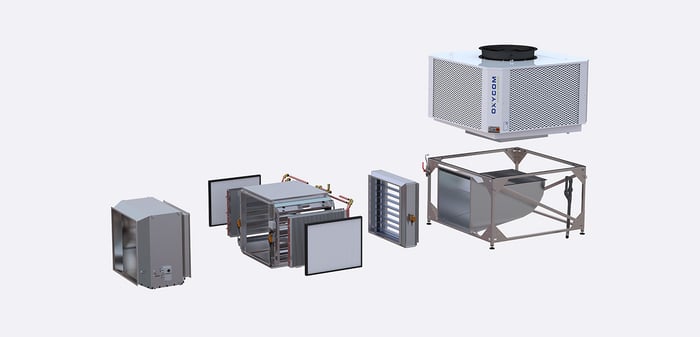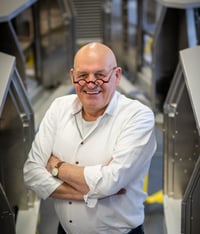Energy prices are a big issue now and this is the right time to look and reflect on the carbon emissions produced by industries. Depending on the country’s energy strategies for either gas or electricity, industrial buildings should be equipped with either heat pump technology or with more efficient cooling and heating technologies.
It all starts with mapping the current situation. Then, preventive measures can be taken and as a result of that, a calculation can be made for the heating, ventilation, and cooling requirements.
1. Analysis of the building (external and internal heat load)
The first and easiest step to get the desired indoor temperature is to analyze the building. To reduce the heating costs, the starting point is to find the external and internal heat load points. The checkpoints of heat load are:
External
- the solar heat/insulation of a building
- the outside air temperature
- infiltration of outside air into the building in case of old, leaky, or cracked building walls
- Ventilated air: the outside cold/hot air that enters the building without pre-treated
Internal
- the heat emitted by the people present
- the electrical lighting
- the heat emitted by equipment and/or the production process
- transmission heat between different sections of the building
For more information on how to calculate the external heat load of your production facility, check out our blog: How to calculate and reduce the heat load of your production facility.
2. Minimize required heating power (energy-saving measures)
After calculating the internal and external heat loads and taking the proper steps to prevent heat loss or heat gain, energy-savings measures can be introduced.
To get insights on how to improve indoor climate efficiently and sustainably, check out our blog: 5 tips to improve the indoor climate of your production facility.
3. Determining heating metrics
Not every building is the same, so it is important to see what is best suited for the building. Every building has different requirements in terms of heating powers and heating needs that are based on the heat delivery system and heating source.
3A) Determining heating needs (how many hours)
3B) Determining heating power (how many KW)
3C) Determining the delivery system
- Indirect-fired air heating by means of an air heater
- Relatively low investment
- Indirectly fired air heating via Heat Reclaim module
- Efficient heating combined with sustainable ventilation and cooling.
- Easy to add to climate control solution, low additional investment.
- Indirectly fired radiant panels
- Zone or local heating is possible
- Radiant heat causes a different perceived temperature, which makes lower hall temperature possible
- Electric radiant panel
- Local heating
- Energy savings due to short heating time, low hall temperature
3D) Determining the heating source
- Electric heating (only when it is a very low heating requirement)
- Late temperature (LT) heat pump
- Medium temperature (MT) heat pump
- High temperature (HT) heat pump
For more information on how to provide heating and ventilation sustainably (with the existing heating source) during winter, check out our blog: Sustainable heating and ventilation for your factory during winter.
4. Installation of the energy–efficient four-season climate control system
Oxycom’s patented IntrCooll climate control system can be combined with a natural ventilator box (no extraction fans needed) and a Heat Reclaim Module to create a healthy, fresh and comfortable indoor climate all year round. Additional heating can be provided by connecting the Heat Reclaim Module with a heat pump.
A carbon dioxide (CO2) measuring device can be connected to our system to deliver the required amount of fresh air in winter or shut off the outdoors completely at night and/or on weekends when no fresh air is needed. The Heat Reclaim Module reuses the residual heat generated from machines, processes, heating, lighting, and people. It filters the indoor recirculated air, then mixes it with filtered fresh air. This supplies the production hall with preheated clean and fresh air.
“We are very satisfied with Oxycom's energy-efficient solution which solved the heat problem in our coating department and assembly line. Now we have a pleasant, constant temperature in summer and winter.”
Heico Booyink (C.O.O. Pan Oston)
Curious to know more about the Heat Reclaim module or the entire IntrCooll installation? Check our IntrCooll page, "IntrCooll: two-stage adiabatic cooling for industrial facilities” or contact us by filling in the form below:




